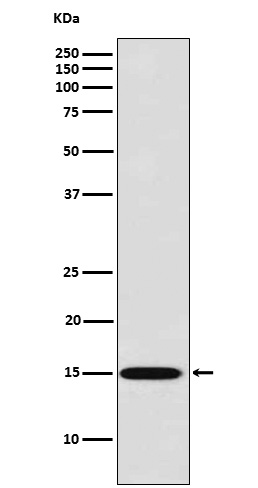
| WB | 1/1000-1/2000 | Human,Mouse,Rat |
| IF | 1/20-1/50 | Human,Mouse,Rat |
| IHC | IHC:1/100-1/200;IHF:1/50-1/200 | Human,Mouse,Rat |
| ICC | 1/50-1/200 | Human,Mouse,Rat |
| FCM | 咨询技术 | Human,Mouse,Rat |
| Elisa | 咨询技术 | Human,Mouse,Rat |
| Aliases | Galectin-7; Gal-7; HKL-14; PI7; LGALS7; PIG1;;Galectin 7 |
| WB Predicted band size | 15 kDa |
| Host/Isotype | Rabbit IgG |
| Antibody Type | Primary antibody |
| Storage | Store at 4°C short term. Aliquot and store at -20°C long term. Avoid freeze/thaw cycles. |
| Species Reactivity | Human |
| Immunogen | A synthesized peptide derived from human Galectin 7 |
| Formulation | Purified antibody in PBS with 0.05% sodium azide,0.05% BSA and 50% glycerol. |
+ +
以下是关于Galectin7抗体的3篇文献摘要概览:
1. **文献名称**:*Galectin-7 expression in invasive breast carcinoma: A potential biomarker for diagnosis and prognosis*
**作者**:Koopmansch B, et al.
**摘要**:该研究利用特异性Galectin7抗体检测其在乳腺癌组织中的表达水平,发现高表达与肿瘤侵袭性和不良预后相关,提示其作为诊断标志物的潜力。
2. **文献名称**:*Galectin-7 promotes colorectal cancer metastasis through integrin-mediated cell adhesion*
**作者**:Madireddi S, et al.
**摘要**:通过免疫组化(Galectin7抗体标记)和功能实验,揭示Galectin7通过整合素信号增强结直肠癌细胞黏附与迁移,促进转移的分子机制。
3. **文献名称**:*Galectin-7 regulates keratinocyte apoptosis and skin wound healing via mitochondrial pathway*
**作者**:García Hernández ML, et al.
**摘要**:研究采用Galectin7抗体敲除小鼠模型,证实Galectin7通过调控线粒体凋亡通路影响角质细胞死亡,进而参与皮肤损伤修复过程。
4. **文献名称**:*Technical challenges in detecting Galectin-7: Antibody specificity and validation methods*
**作者**:Le Mercier M, et al.
**摘要**:综述Galectin7抗体开发中的技术难点,包括交叉反应性问题及多平台验证方法(如Western Blot、免疫荧光),强调标准化检测流程的重要性。
以上研究均以Galectin7抗体为核心工具,覆盖疾病机制、诊断应用及技术优化方向。
Galectin-7. a member of the galectin family of β-galactoside-binding proteins, is a 15-kDa protein encoded by the LGALS7 gene. Primarily expressed in stratified epithelial tissues, particularly the skin, it plays roles in cell-cell adhesion, apoptosis, and differentiation. Galectin-7 is unique among galectins due to its strict homodimeric structure and its regulation by p53. linking it to stress responses and tumor suppression. It is also known as p53-induced gene 1 (PIG1), reflecting its involvement in DNA damage repair pathways. Dysregulation of Galectin-7 has been implicated in cancer progression, with conflicting roles observed: it acts as a tumor suppressor in certain contexts (e.g., colorectal cancer) while promoting metastasis in others (e.g., melanoma). Additionally, it contributes to inflammatory skin disorders like psoriasis and wound healing processes.
Antibodies targeting Galectin-7 are critical tools for studying its localization, expression patterns, and functional mechanisms. They enable detection via techniques such as immunohistochemistry, Western blotting, and flow cytometry. Commercial antibodies are typically raised in rabbits or mice using recombinant human Galectin-7 epitopes. Validation remains challenging due to homology with other galectins, requiring rigorous specificity testing. Recent research explores Galectin-7 antibodies for therapeutic potential, particularly in blocking cancer cell invasion or modulating immune responses. However, its dualistic roles in different microenvironments underscore the need for context-specific antibody applications in both research and clinical settings.
×